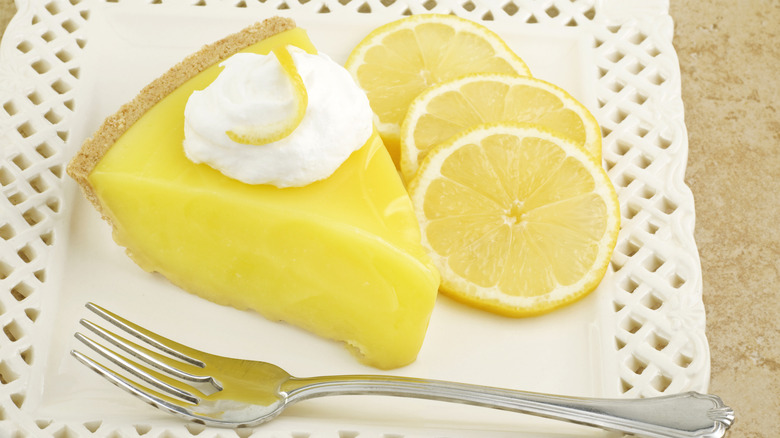The Differences Between Lemon Meringue And Icebox Pie
Lemon meringue and lemon icebox pies might have similarities, but there are some key differences between these beloved treats. While they are each citrusy creations that have long histories in U.S. dessert culture, their textures and preparation methods set them apart. Lemon meringue pies have a tart curd-based filling paired with a marshmallowy topping and flaky pie crust. On the other hand, their icebox counterparts have no-bake creamy fillings. You might often see them topped with whipped cream, giving them a somewhat similar appearance to lemon meringue pie.
Icebox pies are super-easy to make. The filling is a simple concoction of creamy ingredients added to a crust. Rather than baking, the pie is chilled to set before eating. With whipped cream sold in most stores these days, these pies are even easier to finish (although you can always make homemade whipped cream if you're up for it).
Lemon meringue pies, on the other hand, require a tad more skill. It's not exactly difficult to whip up a lemon meringue pie, but knowing certain tips and tricks for working with the eggs will help, and it's a lot easier to make with a kitchen stand mixer (a handheld electric mixer will work, too).
What is lemon meringue pie?
The origin of lemon meringue pie is sometimes credited to different people, but it undoubtedly dates back to at least the 1800s. One popular theory says a woman named Elizabeth Goodfellow was the brains behind lemon meringue, with her signature "Lemon Pudding" recipe from the early 19th century often served in a pie crust and topped with fluffy meringue.
Lemon meringue pies typically have a traditional pie crust base, but many people play around with different types of crust. For example, our lemon meringue pie recipe incorporates a graham cracker crust. As shown by our simple five-ingredient lemon meringue pie recipe, even shortbread cookies can be crumbled up for the pie crust.
Regardless of the crust you choose, the pie incorporates a lemon curd filling and a classic meringue topping. The lemon curd is made with eggs, sugar, butter, and lemon juice (add lemon zest if you're feeling zesty), and the meringue is made by whipping sugar and egg whites until the mixture is fluffy and forms stiff peaks. Once your pie is all put together, into the oven it goes, unlike a no-bake icebox pie.
What is an icebox pie?
Icebox pies got their name because people used to keep them cool in an icebox, which was insulated for food storage before electric refrigerators became commonplace. Becoming popular in the U.S. South, where many people lived in hot, rural areas without electricity, most icebox pies are easy to make and store, without any baking required. They come in many versions, such as strawberry, chocolate, peach, and, of course, the beloved lemon icebox pie.
A lemon icebox pie usually consists of a graham cracker or crushed cookie crust (think vanilla wafers) and a citrusy, creamy custard filling. The custard filling is typically made with cream cheese and condensed milk, plus lemon zest and juice for a bright punch of flavor. They're often topped with whipped cream but can be served without it. However, the versatility of icebox pies means you can get creative with the foundation recipe, incorporating berries and fruit or experimenting with other creamy fillings using ingredients like peanut butter, caramel, or flavored gelatin.


